Micropropagation Effects on Juvenile Traits, Flower Differentiation, and Tree Architecture in Young Olive Trees
Abstract
:1. Introduction
1.1. Intensification of Olive Cultivation
1.2. Micropropagation
1.3. Juvenility
2. Materials and Methods
2.1. Trial 1—‘Arbequina’, ‘Coratina’ and ‘Frantoio’ Varieties Multiplied In Vitro for Several Years
2.2. Trial 2—Orchard Establishment with ‘Arbequina’ Trees
2.3. Trial 3—Field Comparison of ‘Arbequina’ Trees from Cuttings and from Micropropagation
3. Results
3.1. Trial 1
3.2. Trial 2
3.3. Trial 3
3.3.1. Flowering and Fruit Production
3.3.2. Canopy Architecture
4. Discussion
5. Conclusions
Author Contributions
Funding
Acknowledgments
Conflicts of Interest
References
- IOC (International Olive Council). Available online: https://www.internationaloliveoil.org (accessed on 14 October 2020).
- FAO (Food and Agriculture Organization of the United Nations). Available online: http://www.fao.org/faostat/en/#home (accessed on 12 October 2020).
- Tous, J.; Romero, A.; Hermoso, J.F. New trends in olive orchard design for continuous mechanical harvesting. Adv. Hortic. Sci. 2010, 24, 43–52. [Google Scholar]
- Neri, D.; Sansavini, S. Planting and training systems, pruning and fruiting control. Theoretical and practical principles–Physiological. In Principles of Modern Fruit Science-The Ultimate Textbook: Understanding the Fundamentals of Plant Science; Sansavini, S., Costa, G., Gucci, R., Inglese, P., Ramina, A., Xiloyannis, C., Desjardins, Y., Eds.; ISHS: Leuven, Belgium, 2019; pp. 271–293. [Google Scholar]
- Godini, A.; Vivaldi, G.A.; Camposeo, S. Olive cultivars field-tested in super high-density system in southern Italy. Calif. Agric. 2011, 65, 39–40. [Google Scholar] [CrossRef] [Green Version]
- Farinelli, D.; Tombesi, S. Performance and oil quality of ‘Arbequina’ and four Italian olive cultivars under super high-density hedgerow planting system cultivated in central Italy. Sci. Hortic. 2015, 192, 97–107. [Google Scholar] [CrossRef]
- Marino, G.; Macaluso, L.; Marra, F.P.; Ferguson, L.; Marchese, A.; Campisi, G.; Volo, P.; Laudicina, V.A.; Caruso, T. Horticultural performance of 23 Sicilian olive genotypes in hedgerow systems: Vegetative growth, productive potential and oil quality. Sci. Hortic. 2017, 217, 217–225. [Google Scholar] [CrossRef]
- Marino, G.; Macaluso, L.; Grilo, F.; Marra, F.P.; Caruso, T. Toward the valorization of olive (Olea europaea var. europaea L.) biodiversity: Horticultural performance of seven Sicilian cultivars in a hedgerow planting system. Sci. Hortic. 2019, 256, 108583. [Google Scholar] [CrossRef]
- Moutier, N.; Garcia, G.; Lauri, P.E. Shoot architecture of the olive tree: Effect of cultivar on the number and distribution of vegetative and reproductive organs on branches. Acta Hortic. 2004, 635, 689–694. [Google Scholar] [CrossRef]
- Rosati, A.; Paoletti, A.; Caporali, S.; Perri, E. The role of tree architecture in super high-density olive orchards. Sci. Hortic. 2013, 161, 24–29. [Google Scholar] [CrossRef]
- Rosati, A.; Paoletti, A.; Al Hariri, R.; Morelli, A.; Famiani, F. Partitioning of dry matter into fruit explains cultivar differences in vigor in young olive (Olea europaea L.) trees. HortScience 2018, 53, 491–495. [Google Scholar] [CrossRef] [Green Version]
- Proietti, P.; Nasini, L.; Reale, L.; Caruso, T.; Ferranti, F. Productive and vegetative behavior of olive cultivars in super high-density olive grove. Sci. Agric. 2015, 72, 20–27. [Google Scholar] [CrossRef] [Green Version]
- Proietti, P.; Filippucci, M.; Nasini, L.; Regni, L.; Brunori, A. Generative trees: Architectural modelling of an olive to estimate morphology and radiation relationship. In Environmental Information Systems: Concepts, Methodologies, Tools, and Applications; IGI Global: Hershey, PA, USA, 2018; Volume 1, pp. 399–425. [Google Scholar]
- Lodolini, E.M.; Tarragoni, A.; Cioccolanti, T.; Pollastri, L.; Neri, D. Architectural characteristics of six olive cultivars with respect to their suitability for high density orchards. Acta Hortic. 2017, 1160, 127–133. [Google Scholar] [CrossRef]
- Strippoli, G.; Vivaldi, G.A.; Camposeo, S.; Contò, F. Sprouts seasonal elongation of two olive cultivars in high-density orchard. Sci. Res. 2013, 4, 376–381. [Google Scholar] [CrossRef] [Green Version]
- Lodolini, E.M.; Tarragoni, A.; Cioccolanti, T.; Massetani, F.; Pollastri, L.; Neri, D. Reproductive patterns of 1-year-old mixed shoots in different olive cultivars in Central Italy. Acta Hortic. 2017, 1160, 119–126. [Google Scholar] [CrossRef]
- Vivaldi, G.A.; Strippoli, G.; Pascuzzi, S.; Stellacci, A.M.; Camposeo, S. Olive genotypes cultivated in an adult high-density orchard respond differently to canopy restraining by mechanical and manual pruning. Sci. Hortic. 2015, 192, 391–399. [Google Scholar] [CrossRef]
- Lodolini, E.M.; Polverigiani, S.; Grossetti, D.; Neri, D. Pruning management in a high-density olive orchard in central Italy. Acta Hortic. 2018, 1199, 385–390. [Google Scholar] [CrossRef]
- Albarracin, V.; Hall, A.J.; Searles, P.S.; Rousseaux, M.C. Responses of vegetative growth and fruit yield to winter and summer mechanical pruning in olive trees. Sci. Hortic. 2017, 225, 185–194. [Google Scholar] [CrossRef]
- Albarracin, V.; Hall, A.J.; Searles, P.S.; Rousseaux, M.C. Impact of simulated mechanical hedge pruning and wood age on new shoot demography and return flowering in olive trees. Trees 2018, 32, 1767–1777. [Google Scholar] [CrossRef] [Green Version]
- Albarracin, V.; Hall, A.J.; Searles, P.S.; Rousseaux, M.C. Responses of shoot growth, return flowering, and fruit yield to post-pruning practices and growth regulator application in olive trees. Sci. Hortic. 2019, 254, 163–171. [Google Scholar] [CrossRef]
- Famiani, F.; Proietti, P.; Lodolini, E.M.; Neri, D. Gestione della chioma. In L’ulivo e l’olio; Ed. Script: Bologna, Italy, 2009; pp. 390–411. [Google Scholar]
- Tombesi, S.; Farinelli, D. Canopy management in super high-density olive orchards: Relationship between canopy light penetration, canopy size and productivity. Acta Hortic. 2017, 1177, 87–91. [Google Scholar] [CrossRef]
- Cioccolanti, T.; Lodolini, E.M.; Neri, D.; Bastianelli, M.; Zuccherelli, G.; Capaccio, V.; Navacchi, O. Giovanilità dell’Olivo in micropropagazione (Juvenility in micropagated olive trees). Acta ItalusHortus 2013, 10, 102–105. [Google Scholar]
- Cioccolanti, T.; Lodolini, E.M.; Neri, D.; Perez, V.; Zuccherelli, G. Modello architetturale in piante micropropagate e da talea (cv Arbequina). Acta ItalusHortus 2013, 10, 50–54. [Google Scholar]
- Lambardi, M.; Ozudogru, A.E. La propagazione in vitro dei portinnesti e delle specie da frutto. Frutticoltura 2010, 12, 18–25. [Google Scholar]
- Zuccherelli, G.; Zuccherelli, S. In vitro propagation of fifty olive cultivars. Acta Hortic. 2002, 586, 931–934. [Google Scholar] [CrossRef]
- Capocasa, F.; Balducci, F.; Marcellini, M.; Bernardini, D.; Navacchi, O.; Mezzetti, B. Comparing nursery behavior, field plant yield and fruit quality of in vitro and in vivo propagated strawberry mother plants. Plant Cell Tiss. Organ. Cult. 2019, 136, 65–74. [Google Scholar] [CrossRef] [Green Version]
- Bednarek, P.T.; Orlowska, R. Plant tissue culture environment as a switch-key of (epi)genetic changes. Plant Cell Tissue Organ. Cult. 2019, 140, 245–257. [Google Scholar] [CrossRef] [Green Version]
- Neri, D. Giovanilità e ringiovanimento nelle piante arboree. Frutticoltura 1990, 12, 69–73. [Google Scholar]
- Hackett, W.P. Juvenility, maturation and rejuvenation in woody plants. Hortic. Rev. 1985, 7, 109–155. [Google Scholar]
- Fabbri, A.; Bartolini, G.; Lambardi, M.; Kailis, S. Olive Propagation Manual; Landlinks Press: Collingwood, Australia, 2004; p. 144. [Google Scholar]
- Goldschmidt, E.E.; Samach, A. Aspects of flowering in fruit trees. Acta Hortic. 2004, 653, 23–27. [Google Scholar] [CrossRef]
- Merkle, S.A.; Battle, P.J. Enhancement of embryogenic culture initiation from tissues of mature sweetgum trees. Plant Cell Rep. 2000, 19, 268–273. [Google Scholar] [CrossRef]
- Araki, T. Transition from vegetative to reproductive phase. Curr. Opin. Plant Biol. 2001, 4, 63–68. [Google Scholar] [CrossRef]
- Gucci, R.; Cantini, C. Pruning and Training Systems for Modern Olive Growing; CSIRO Publishing: Collingwood, Australia, 2000; p. 147. [Google Scholar]
- Zucconi, F. Nanizzazione Delle Piante Arboree; Spazio Verde: Padova, Italy, 1996; p. 128. [Google Scholar]
- Zucconi, F. Nuove Tecniche per i Fruttiferi: Fisiologia e Metodi Innovative Nell’allevamento dei Fruttiferi; Edagricole: Bologna, Italy, 2003; p. 246. [Google Scholar]
- Lodolini, E.M.; Neri, D. How growth and reproduction cycles affect alternate bearing in olive. Acta Hortic. 2012, 949, 191–198. [Google Scholar] [CrossRef]
- Leva, A.R.; Petruccelli, R.; Montagni, G.; Muleo, R. Field performance of micropropagated olive plants (cv Maurino): Morphological and molecular features. Acta Hortic. 2002, 586, 891–894. [Google Scholar] [CrossRef]
- Briccoli Bati, C.; Godino, G.; Nuzzo, V. Preliminary agronomic evaluation of two olive cultivars obtained from micropropagation methods. Acta Hortic. 2002, 586, 867–870. [Google Scholar] [CrossRef]
- Lambardi, M.; Rugini, E. Micropropagation of olive (Olea europaea L.). In Micropropagation of Woody Trees and Fruits; Jain, S.M., Ishii, K., Eds.; Springer: Basel, Switzerland, 2003; pp. 621–646. [Google Scholar]
- Bastianelli, M.; Cioccolanti, T. Tutte le declinazioni del mondo spagnolo–reportage da Valdejalon dove l’Arbequina ad alta densità è rapidamente proliferata grazie alla precoce entrata in produzione e ai bassi costi di gestione. Ma ogni produttore gestisce l’allevamento “in libertà”. Le prospettive della micropropagazione. Olivo e Olio 2012, 2, 54–57. [Google Scholar]
- Lodolini, E.M.; Cioccolanti, T.; Bastianelli, M.; Zuccherelli, G.; Capaccio, V.; Navacchi, O.; Neri, D. Giovanilità e vigoria in piante di olivo micropropagato. Acta ItalusHortus 2012, 6, 106. [Google Scholar]
- Cioccolanti, T.; Lodolini, E.M.; Bastianelli, M.; Zuccherelli, G.; Capaccio, V.; Navacchi, O.; Neri, D. Selezione precoce di germogli di olivo micropropagato in base al diverso livello di vigoria. Acta ItalusHortus 2012, 6, 110. [Google Scholar]
- Kumar, N.; Reddy, M.P. In vitro plant propagation: A review. J. For. Sci. 2011, 27, 61–72. [Google Scholar]

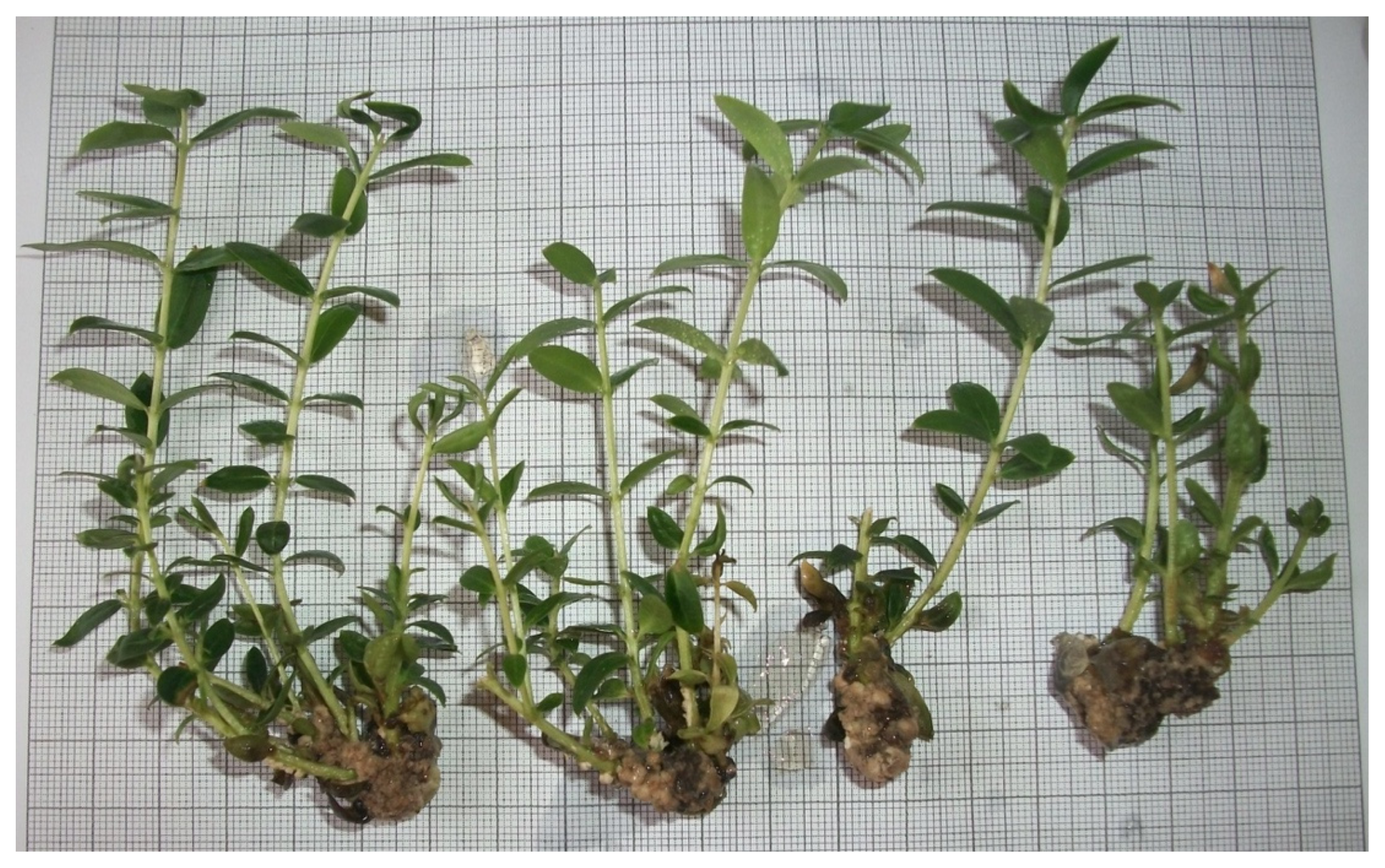
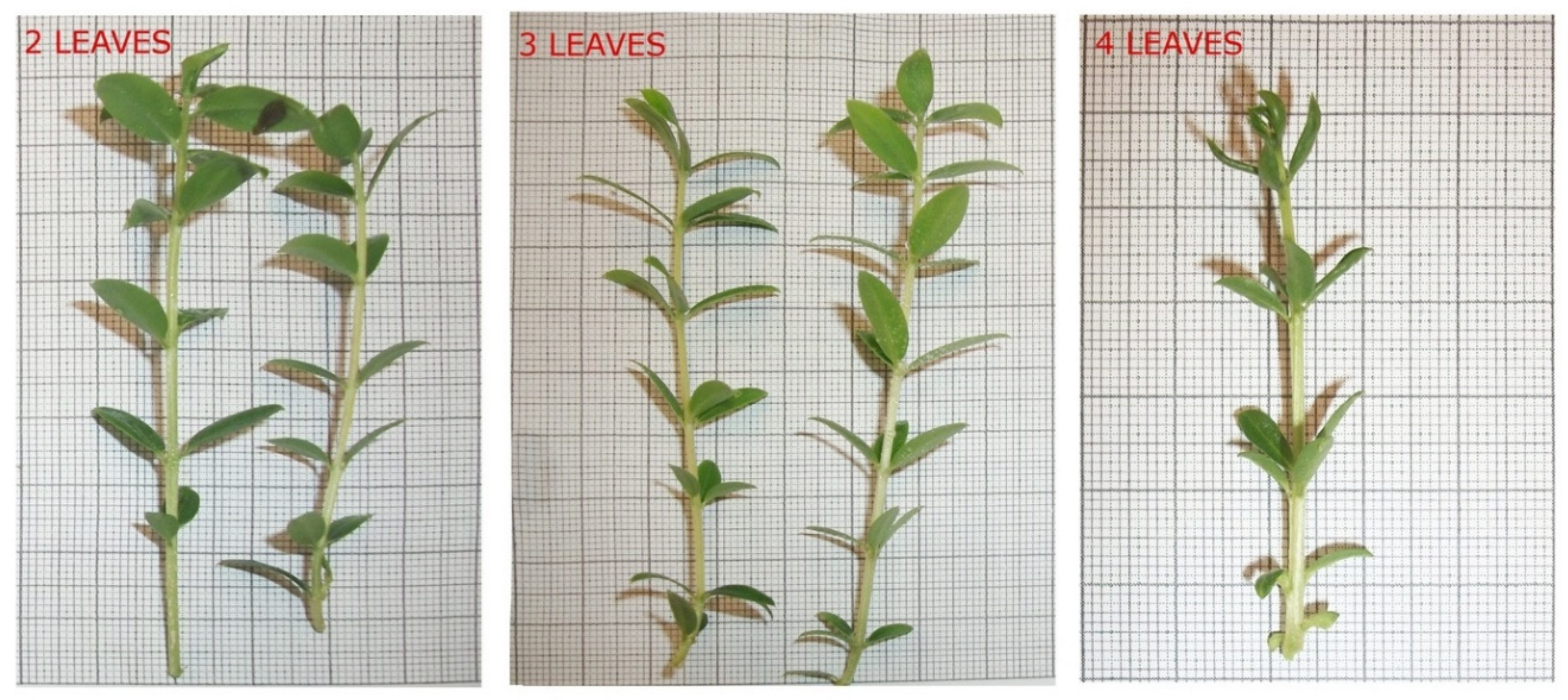
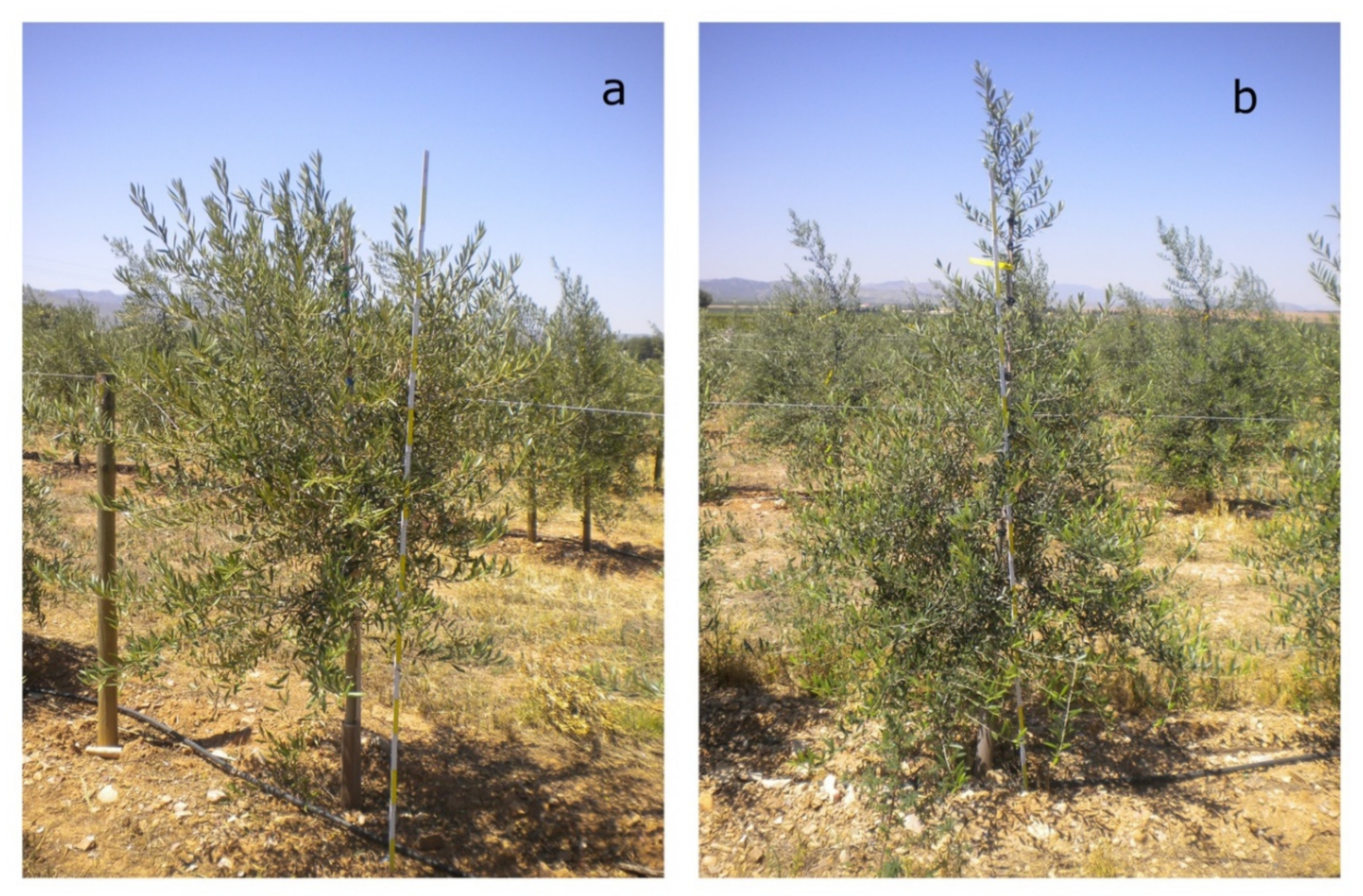
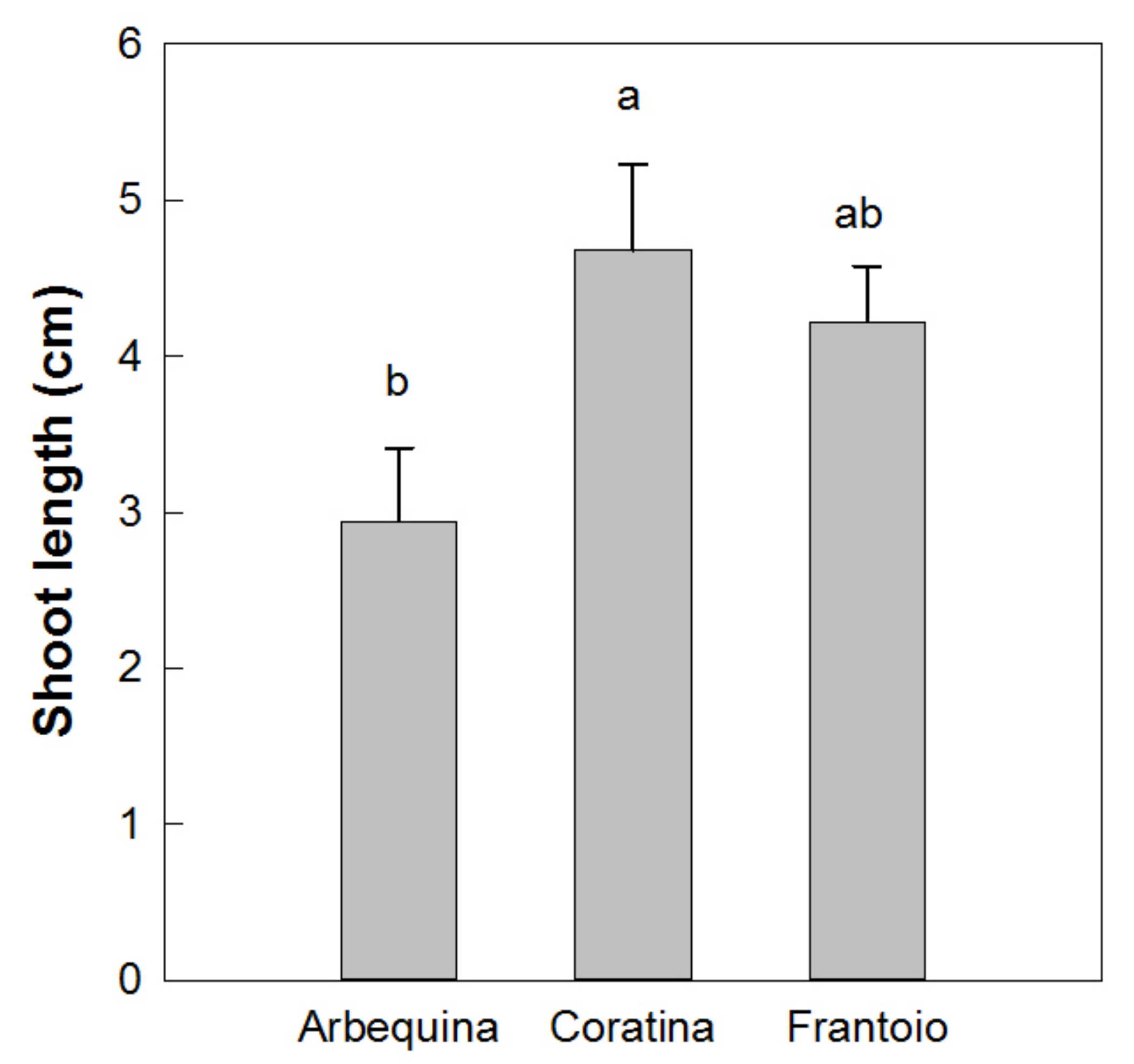
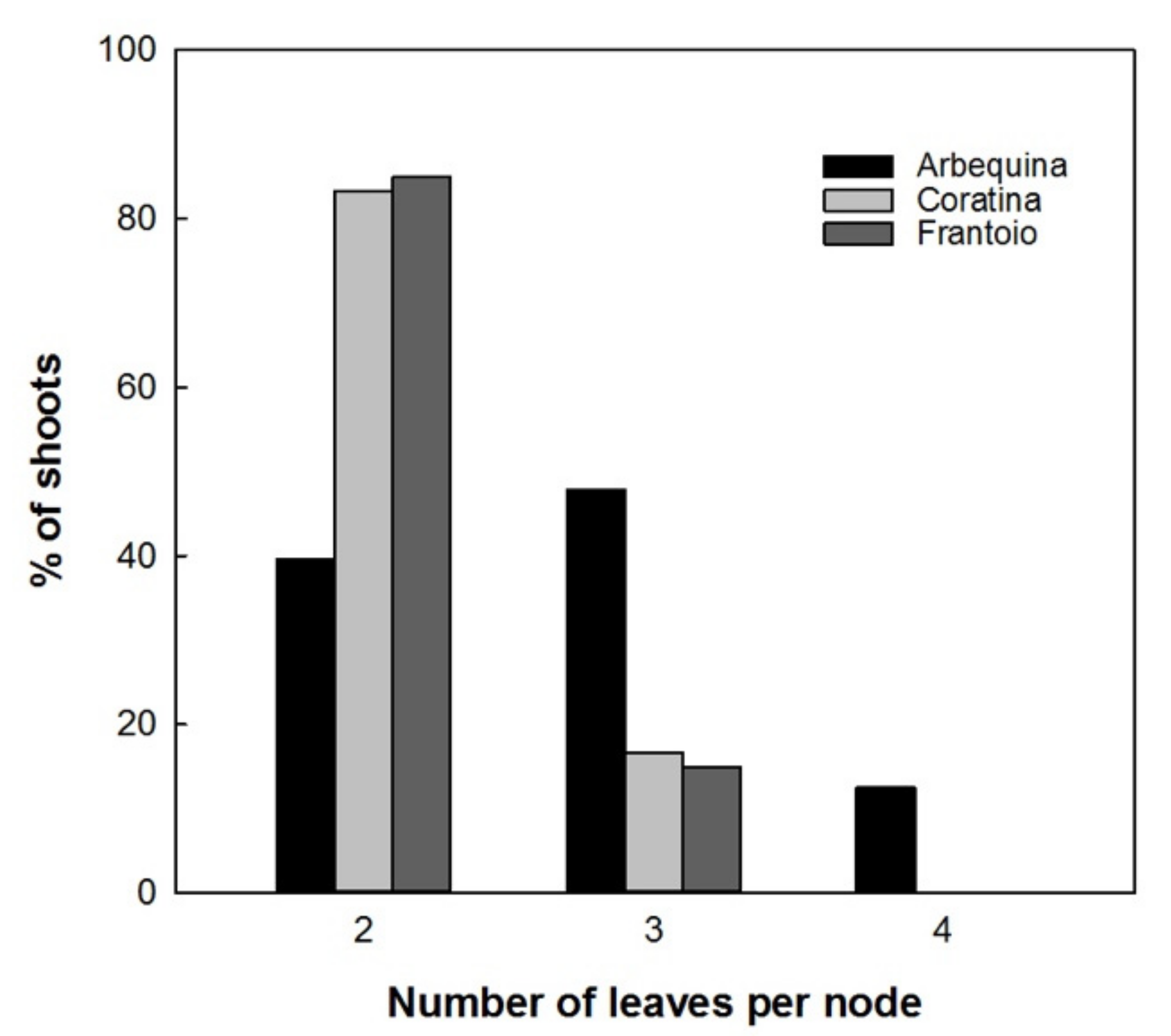
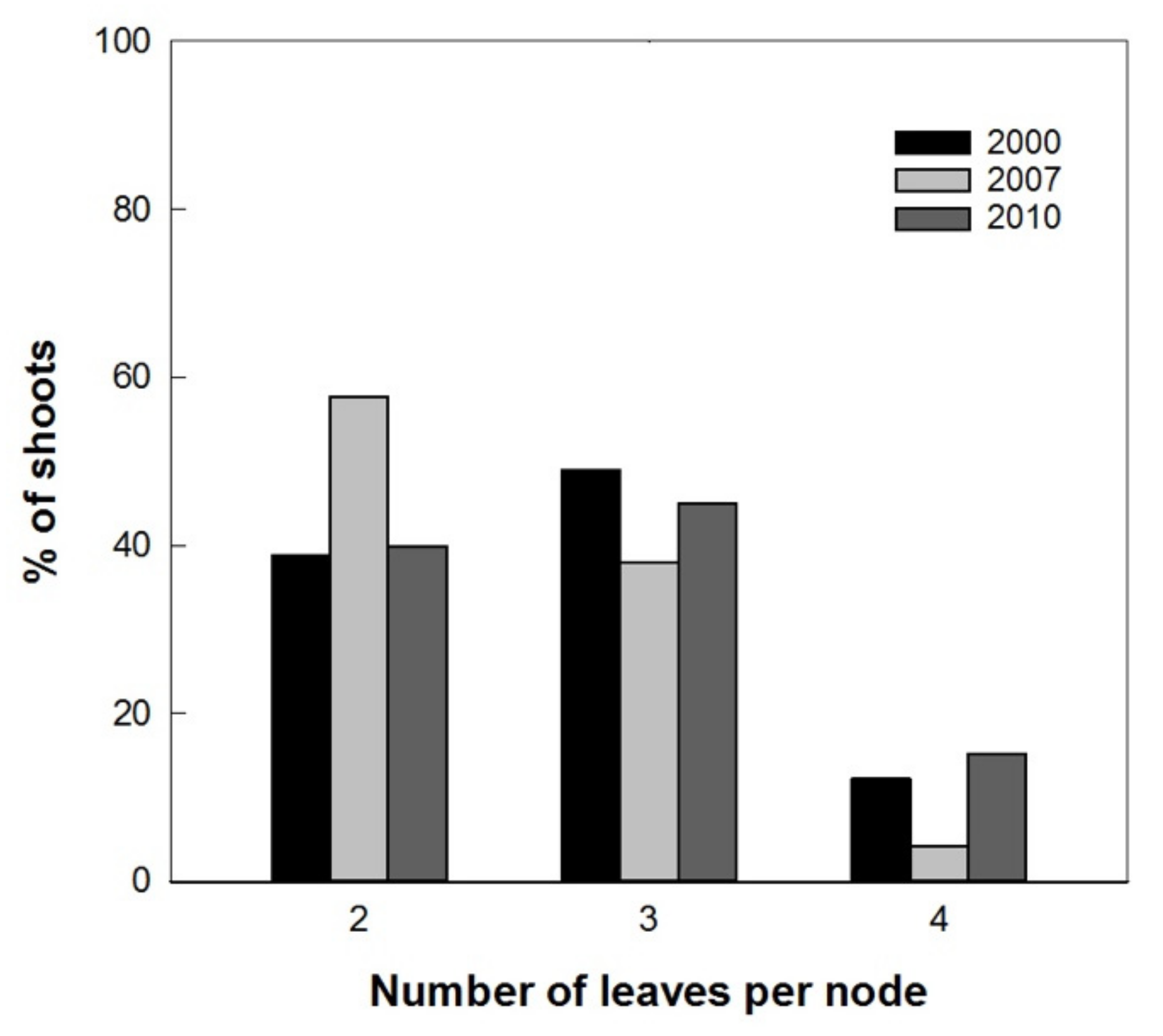


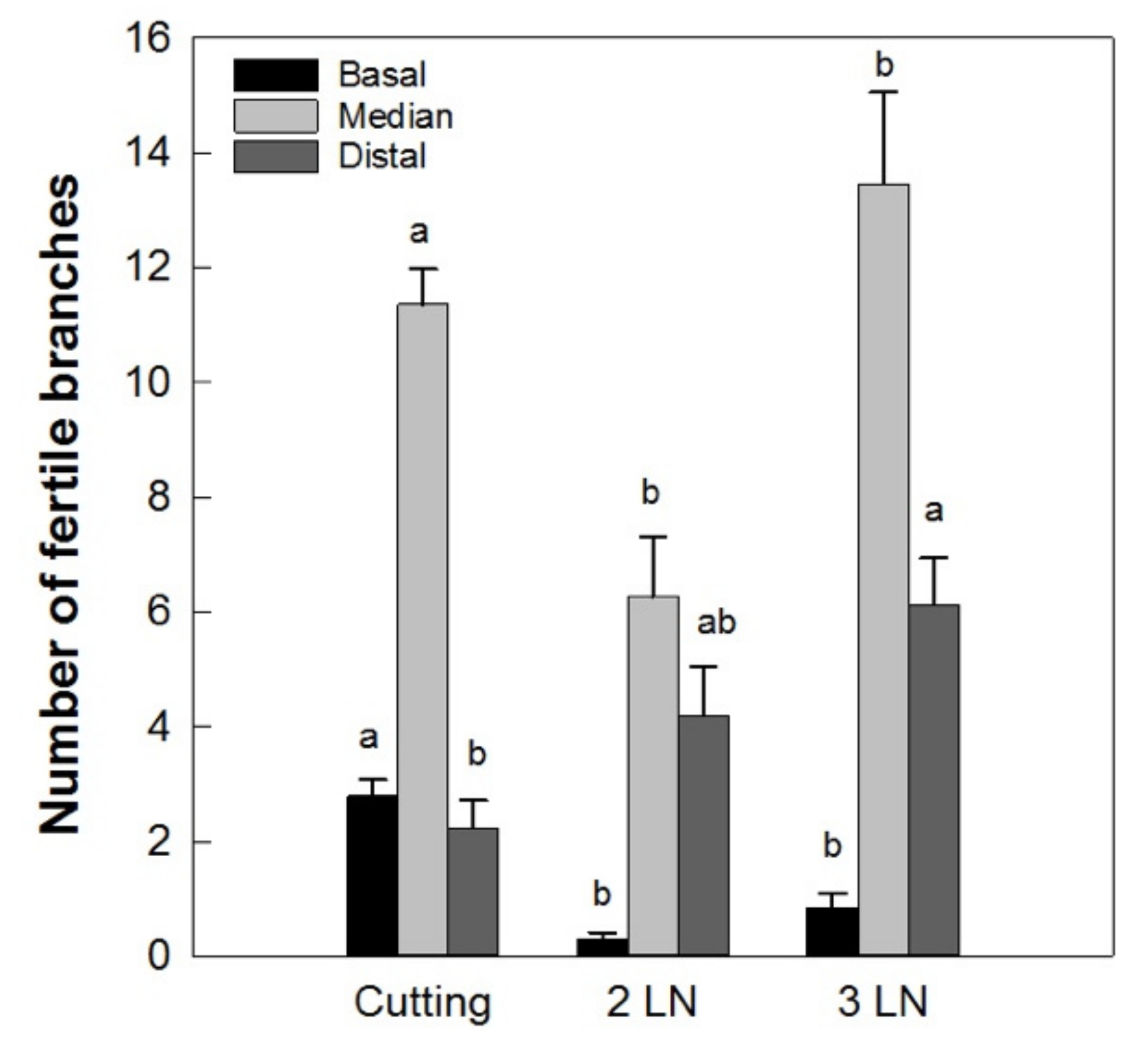
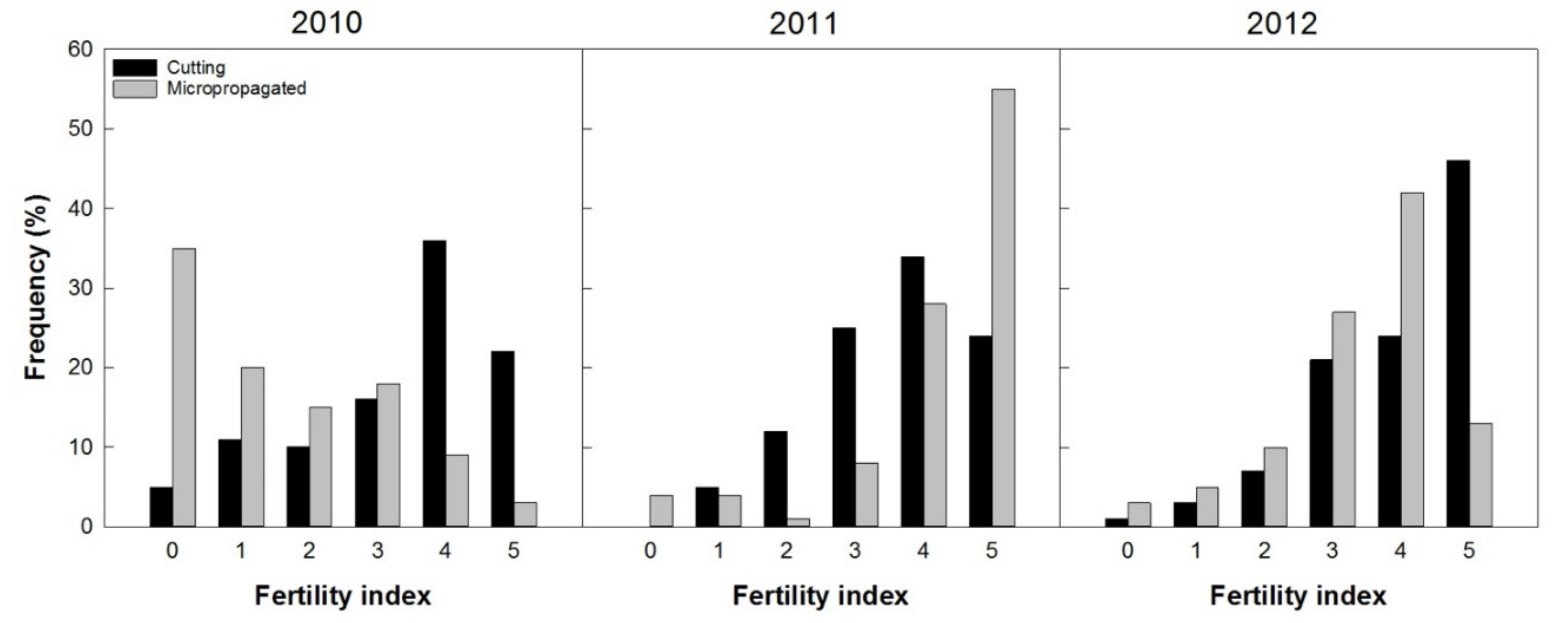
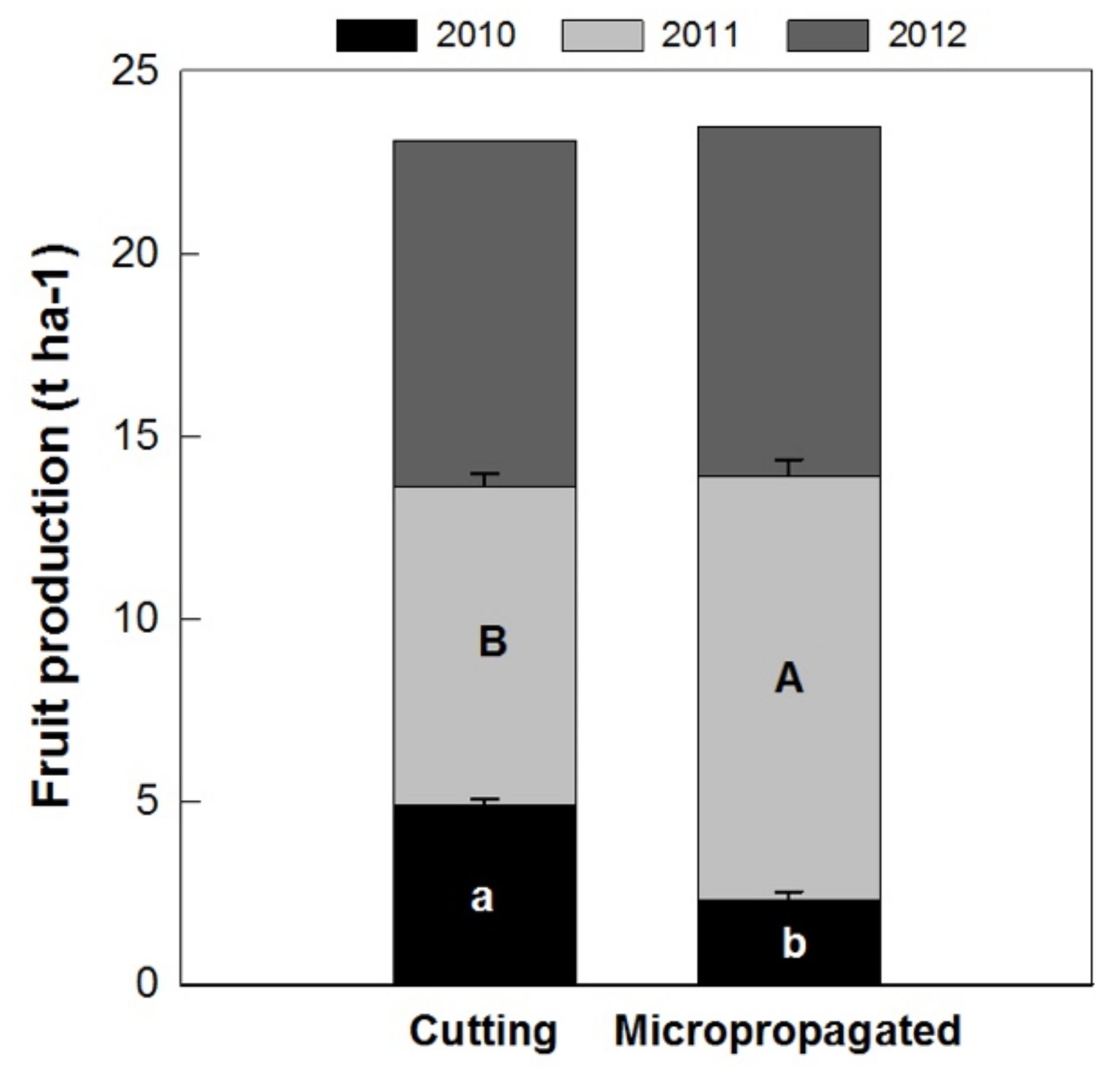
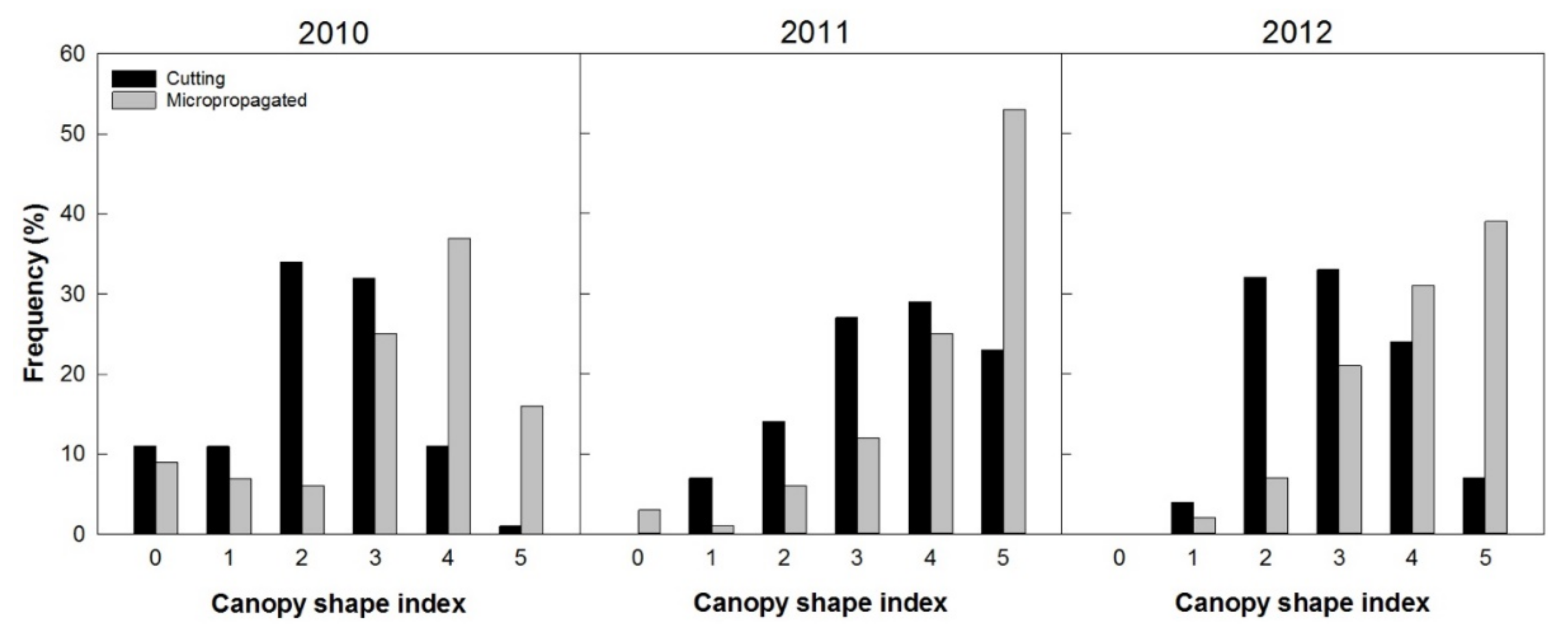
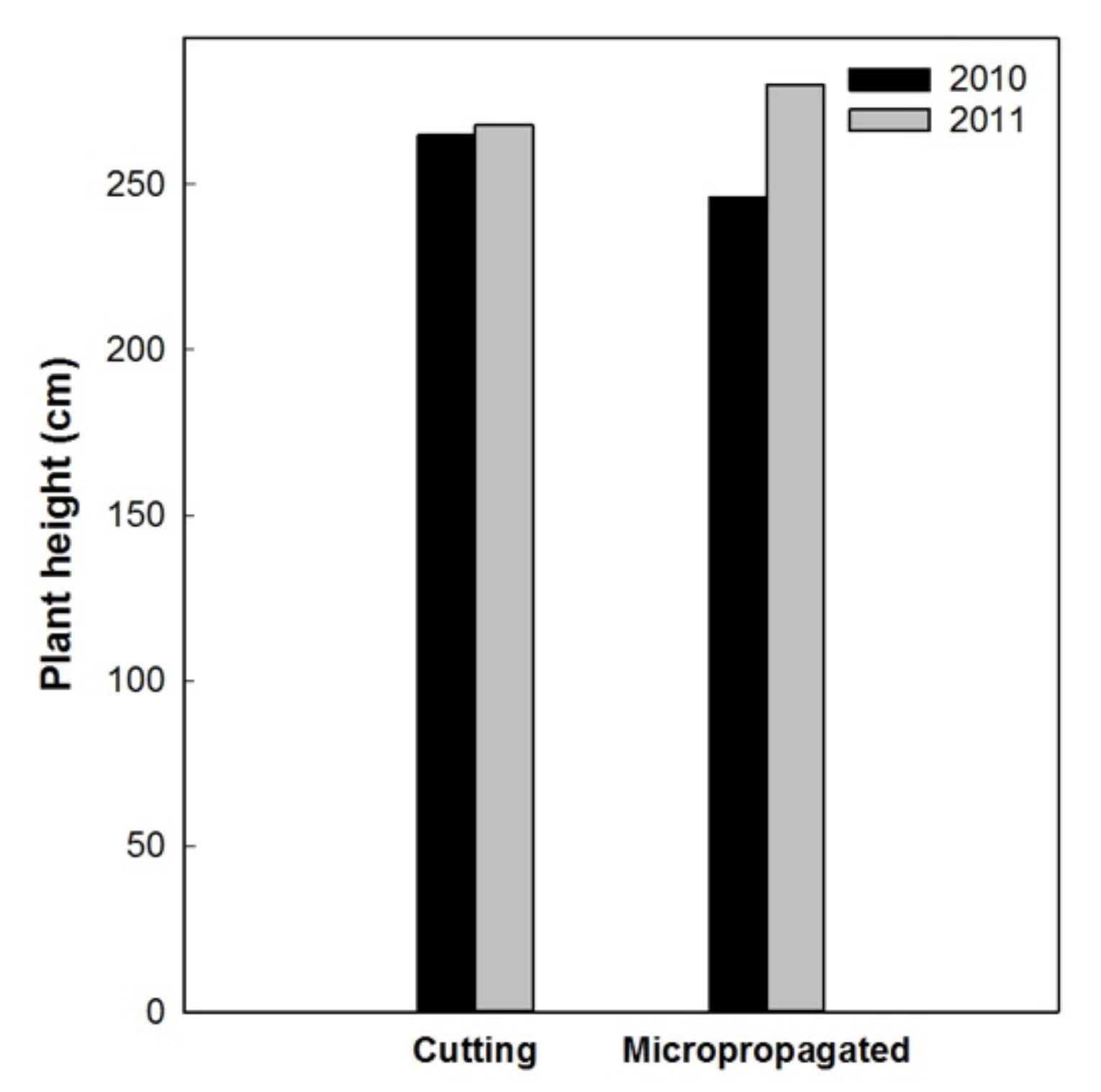

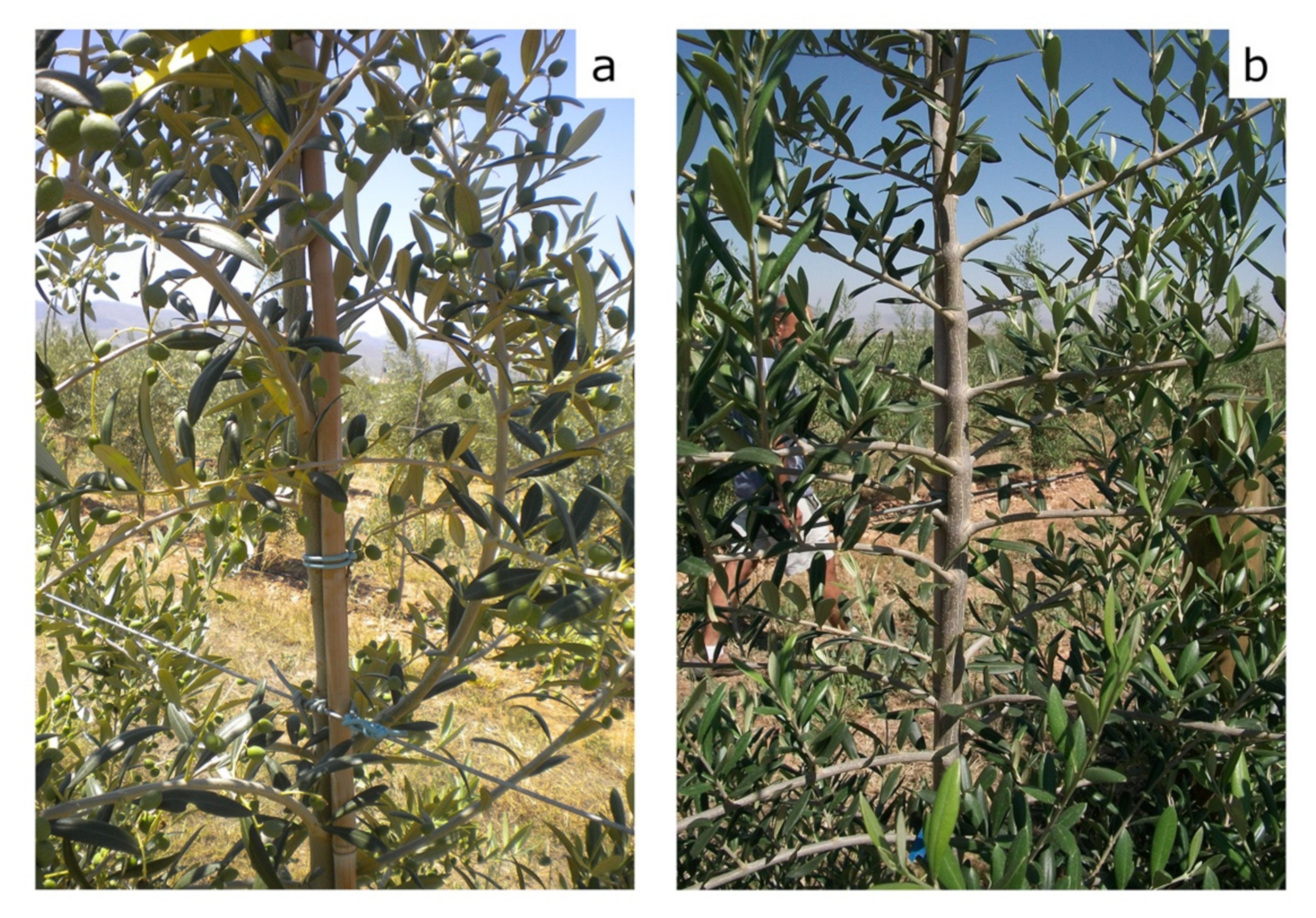
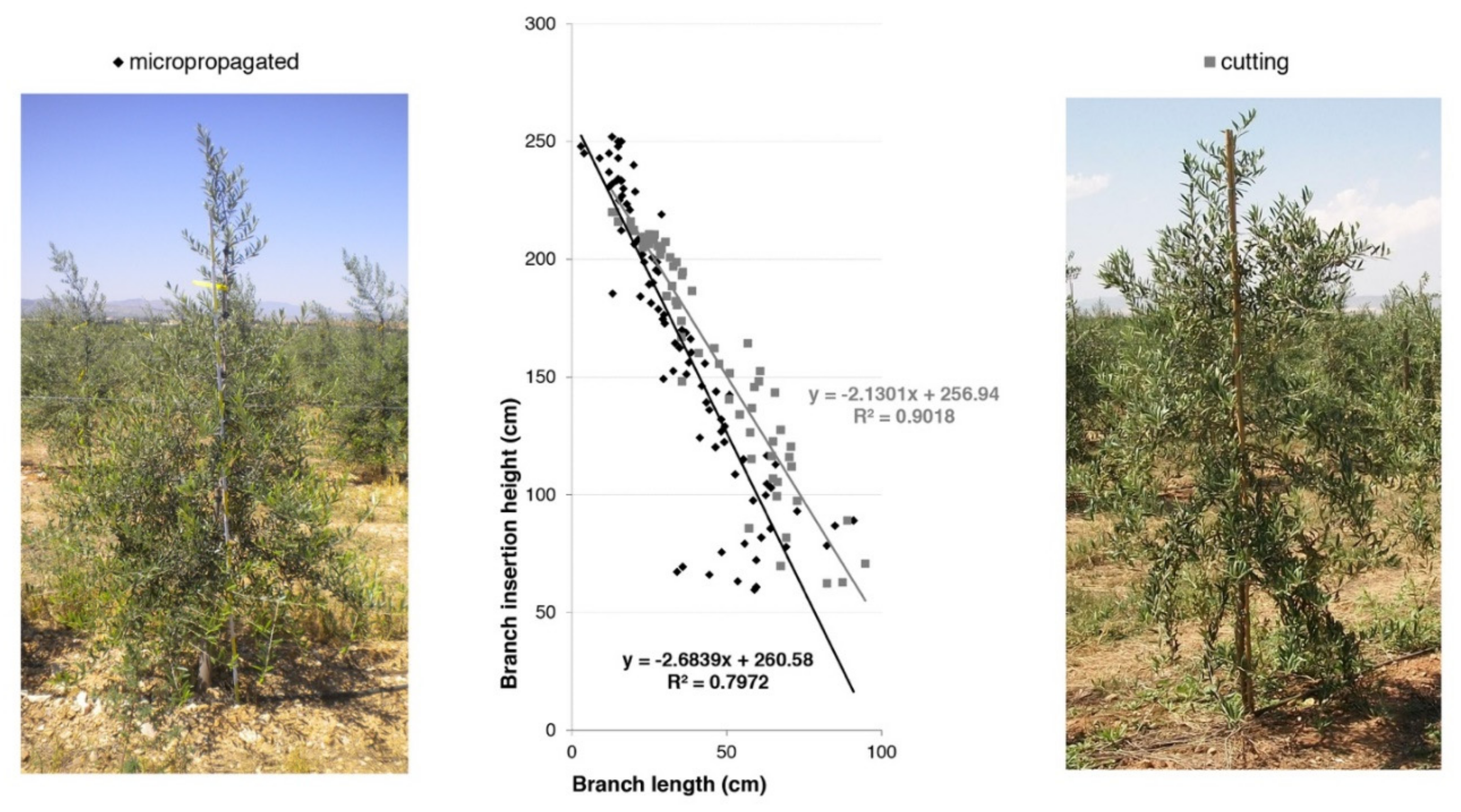

Publisher’s Note: MDPI stays neutral with regard to jurisdictional claims in published maps and institutional affiliations. |
© 2020 by the authors. Licensee MDPI, Basel, Switzerland. This article is an open access article distributed under the terms and conditions of the Creative Commons Attribution (CC BY) license (http://creativecommons.org/licenses/by/4.0/).
Share and Cite
Neri, D.; Cioccolanti, T.; Zuccherelli, G.; Navacchi, O.; Giorgi, V.; Lodolini, E.M. Micropropagation Effects on Juvenile Traits, Flower Differentiation, and Tree Architecture in Young Olive Trees. Agronomy 2020, 10, 1742. https://doi.org/10.3390/agronomy10111742
Neri D, Cioccolanti T, Zuccherelli G, Navacchi O, Giorgi V, Lodolini EM. Micropropagation Effects on Juvenile Traits, Flower Differentiation, and Tree Architecture in Young Olive Trees. Agronomy. 2020; 10(11):1742. https://doi.org/10.3390/agronomy10111742
Chicago/Turabian StyleNeri, Davide, Tonino Cioccolanti, Giuseppe Zuccherelli, Oriano Navacchi, Veronica Giorgi, and Enrico Maria Lodolini. 2020. "Micropropagation Effects on Juvenile Traits, Flower Differentiation, and Tree Architecture in Young Olive Trees" Agronomy 10, no. 11: 1742. https://doi.org/10.3390/agronomy10111742





